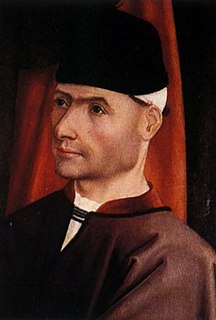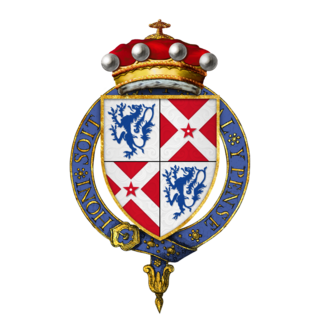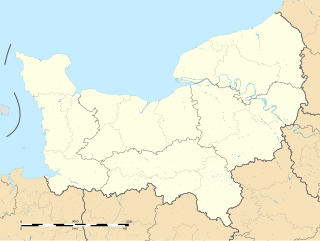William I, usually known as William the Conqueror and sometimes William the Bastard, was the first Norman King of England, reigning from 1066 until his death in 1087. He was a descendant of Rollo and was Duke of Normandy from 1035 onward. His hold was secure on Normandy by 1060, following a long struggle to establish his throne, and he launched the Norman conquest of England six years later. The rest of his life was marked by struggles to consolidate his hold over England and his continental lands, and by difficulties with his eldest son, Robert Curthose.

Jean d'Orléans, Count of Dunois, known as the "Bastard of Orléans" or simply Jean de Dunois, was a French military leader during the Hundred Years' War who participated in military campaigns with Joan of Arc. He was the illegitimate son of Louis I, Duke of Orléans – himself a son of King Charles V of France – and his mistress Mariette d'Enghien. His nickname, the "Bastard of Orléans", was a term of higher hierarchy and respect, since it acknowledged him as a first cousin to the king and acting head of a cadet branch of the royal family during his half-brother's captivity. In 1439 he received the county of Dunois from his half-brother Charles, Duke of Orléans, and later king Charles VII made him count of Longueville.

The Battle of Formigny, fought on 15 April 1450, was a major battle of the Hundred Years' War between the kingdom of England and the kingdom of France. The destruction of England's last army in Normandy in the battle and the decisive French victory paved the way for the capture of the remaining English strongholds in Normandy.

Les Andelys is a commune in the northern French department of Eure, in Normandy.

Château Gaillard is a medieval castle ruin overlooking the River Seine above the commune of Les Andelys, in the French department of Eure, in Normandy. It is located some 95 kilometres (59 mi) north-west of Paris and 40 kilometres (25 mi) from Rouen. Construction began in 1196 under the auspices of Richard the Lionheart, who was simultaneously King of England and feudal Duke of Normandy. The castle was expensive to build, but the majority of the work was done in an unusually short period of time. It took just two years and, at the same time, the town of Petit Andely was constructed. Château Gaillard has a complex and advanced design, and uses early principles of concentric fortification; it was also one of the earliest European castles to use machicolations. The castle consists of three enclosures separated by dry moats, with a keep in the inner enclosure.

Jean Bureau was a French artillery commander active primarily during the later years of the Hundred Years' War. Along with his brother, Gaspard, he is credited with making French artillery the most effective in the world. As Master Gunner of Artillery in the armies of Charles VII, Bureau acquired a reputation as an effective artillery officer during the Normandy campaign (1449–1450), when his bombardments helped capture the towns of Rouen, Harfleur, and Honfleur, and aided in the French victory at Formigny. Bureau commanded the victorious French army at the decisive Battle of Castillon in 1453.

Verneuil-sur-Avre is a former commune in the Eure department in Normandy in northern France. On 1 January 2017, it was merged into the new commune Verneuil d'Avre et d'Iton.

John II of Alençon was the son of John I of Alençon and his wife Marie of Brittany, Lady of La Guerche (1391–1446), daughter of John V, Duke of Brittany, and Joan of Navarre. He succeeded his father as Duke of Alençon and Count of Perche as a minor in 1415, after the latter's death at the Battle of Agincourt. He is best known as a general in the Last Phase of the Hundred Years' War and for his role as a comrade-in-arms of Joan of Arc, who called him "le beau duc".

Arques-la-Bataille is a commune in the Seine-Maritime department in the Normandy region in north-western France.

The Battle of Gerberoy was fought in 1435 between French and English forces. The French were led by La Hire and Jean Poton de Xaintrailles, who were victorious. The English losses were heavy, which later included their commander, John FitzAlan, 14th Earl of Arundel.

William Neville, 1st Earl of Kent KG and jure uxoris 6th Baron Fauconberg, was an English nobleman and soldier. He fought during the latter part of the Hundred Years War, and during the English dynastic Wars of the Roses.
Events from the 1440s in England.

The Hundred Years' War was a series of conflicts in Western Europe from 1337 to 1453, waged between the House of Plantagenet and its cadet House of Lancaster, rulers of the Kingdom of England, and the House of Valois over the right to rule the Kingdom of France. It was one of the most notable conflicts of the Middle Ages, in which five generations of kings from two rival dynasties fought for the throne of the largest kingdom in Western Europe. The war marked both the height of chivalry and its subsequent decline, and the development of stronger national identities in both countries.

Rouen Castle was a fortified ducal and royal residence in the city of Rouen, capital of the duchy of Normandy, now in France. With the exception of the tower wrongly associated with Joan of Arc, which was restored by Viollet-le-Duc, the castle was destroyed at the end of the 16th century, its stones quarried for other construction.
Sir William Oldhall (1390?–1460) was an English soldier and Yorkist supporter, who served as Speaker of the House of Commons of England between 1450–51.

Sir John Popham was MP for Hampshire and Sheriff of Hampshire. He was a military commander and speaker-elect of the House of Commons. He took part in Henry V's invasion of France in 1415 and in the French wars under John of Lancaster, 1st Duke of Bedford. He was elected Speaker of the House of Commons in 1449 but was permitted by King Henry VI to decline the office on the ground of infirmity.

Château de Saint-Lô was a castle in Saint-Lô, Normandy, France.
The Siege of Cherbourg took place in 1450 during the Hundred Years War when French forces laid siege to Cherbourg in the English-controlled Duchy of Normandy following their decisive victory at the Battle of Formigny. With the fall of Cherbourg, English control of Normandy was removed.
The Siege of Falaise took place in 1450 during the Hundred Years War when French forces laid siege to Falaise in the English-controlled Duchy of Normandy following their decisive victory at the Battle of Formigny.
The Gascon campaign of 1450-1453 took place during the Hundred Years War when the kingdom of France undertook a military campaign to invade and cede the Duchy of Gascony from the English. Following the decisive victory of the French at the battle of Castillion and after the fall of Bordeaux, the last English stronghold in Gascony, English control of Gascony was removed.













